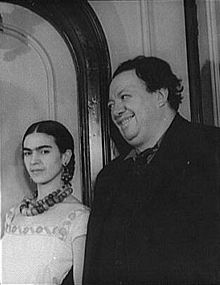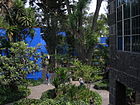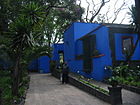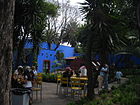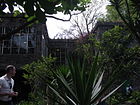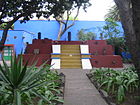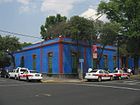- Frida Kahlo
-
Frida Kahlo 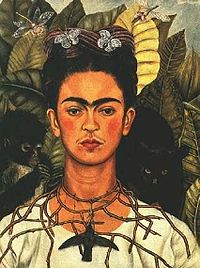
Frida Kahlo, Self-portrait with Thorn Necklace and Hummingbird, Nikolas Muray Collection, Harry Ransom Center, The University of Texas at Austin[1]Birth name Magdalena Carmen Frieda[2] Kahlo y Calderón Born July 6, 1907
Coyoacán, MexicoDied July 13, 1954 (aged 47)
Coyoacán, MexicoNationality Mexican Field Painting Training Self–taught Movement Surrealism Works in museums:
- Albright-Knox Art Gallery, Buffalo, New York
- Fundación Proa, Buenos Aires, Argentina
- Frida Kahlo Museum, Coyoacán section of Mexico City
- Harry Ransom Center, University of Texas at Austin
- Madison Museum of Contemporary Art, Wisconsin
- Museo Dolores Olmedo, Xochimilco, Mexico City
- Museo de Arte Moderno, Instituto Nacional de Bellas Artes, Mexico City
- Museum of Modern Art, New York City
- Phoenix Art Museum, Phoenix, Arizona
- San Francisco Museum of Modern Art, California
Patrons and friends:
- Julian Levy Gallery, New York City
- Renou & Colle Gallery, Paris
- Nickolas Muray
- Lola Alvarez Bravo
- Marcel Duchamp
- André Breton
Frida Kahlo de Rivera (July 6, 1907 – July 13, 1954; born Magdalena Carmen Frieda Kahlo y Calderón)[2][3] was a Mexican painter, born in Coyoacán,[4] and perhaps best known for her self-portraits.[5]
Kahlo's life began and ended in Mexico City, in her home known as the Blue House. She gave her birth date as July 7, 1910, but her birth certificate shows July 6, 1907. Kahlo had allegedly wanted the year of her birth to coincide with the year of the beginning of the Mexican revolution so that her life would begin with the birth of modern Mexico. At the age of six, Frida developed polio, which caused her right leg to appear much thinner than the other. It was to remain that way permanently.[6] Her work has been celebrated in Mexico as emblematic of national and indigenous tradition, and by feminists for its uncompromising depiction of the female experience and form.[7]
Mexican culture and Amerindian cultural tradition are important in her work, which has been sometimes characterized as Naïve art or folk art.[8] Her work has also been described as "surrealist", and in 1938 André Breton, principal initiator of the surrealist movement, described Kahlo's art as a "ribbon around a bomb".[7]
Kahlo had a volatile marriage with the famous Mexican artist Diego Rivera. She suffered lifelong health problems, many of which derived from a traffic accident during her teenage years. These issues are represented in her works, many of which are self-portraits of one sort or another. Kahlo suggested, "I paint myself because I am so often alone and because I am the subject I know best."[9] She also stated, "I was born a bitch. I was born a painter."[10]
Contents
Childhood and family
Frida Kahlo was born on July 6, 1907 in the house of her parents, known as La Casa Azul (The Blue House), in Coyoacán. At the time, Coyoacan was a small town on the outskirts of Mexico City.
Her father, Guillermo Kahlo (1871–1941), was born Carl Wilhelm Kahlo in Pforzheim, Germany, the son of Jakob Heinrich Kahlo and Henriette Kaufmann. While Frida maintained that her father was of Hungarian-Jewish ancestry,[11] one set of researchers has established that Guillermo Kahlo's parents were not Jewish, but Lutheran Germans.[12] Carl Wilhelm Kahlo traveled to Mexico during 1891 at the age of nineteen years and, upon his arrival, changed his German forename, Wilhelm, to its Spanish equivalent, Guillermo.
Frida's mother, Matilde Calderón y Gonzalez, was a devout Roman Catholic of primarily Amerindian, as well as Spanish, ancestry.[13] Frida's parents were married soon after the death of Guillermo's first wife, which occurred during the birth of her second child. Although their marriage was quite unhappy, Guillermo and Matilde had four daughters, with Frida being the third. She had two older half sisters who were raised in the same household. Frida remarked that she grew up in a world surrounded by females. However, during most of her life, Frida remained amicable with her father.
The Mexican Revolution began during 1910, when Kahlo was three years old. Kahlo later claimed that she was born in 1910, allegedly so that people would associate her with the revolution. In her writings, she recalled that her mother would usher her and her sisters inside the house as gunfire echoed in the streets of her hometown.
Kahlo contracted polio at age six, which left her right leg thinner than the left, which she disguised by wearing long, colorful skirts. It has been conjectured that she also suffered from spina bifida, a congenital disease that could have affected both spinal and leg development.[14] As a girl, she participated in boxing and other sports. In 1922, Kahlo was enrolled in the Preparatoria, one of Mexico's premier schools, where she was one of only thirty-five girls. Kahlo joined a clique at the school and became enamored of the strongest personality of it, Alejandro Gómez Arias. During this period, Kahlo also witnessed violent armed struggles in the streets of Mexico City as the Mexican Revolution continued.
On September 17, 1925, Kahlo was riding in a bus that collided with a trolley car. She suffered serious injuries as a result of the accident, including a broken spinal column, a broken collarbone, broken ribs, a broken pelvis, eleven fractures in her right leg, a crushed and dislocated right foot, and a dislocated shoulder. Also, an iron handrail pierced her abdomen and her uterus, which seriously damaged her reproductive ability.
The accident left her in a great deal of pain while she spent three months recovering in a full body cast. Although she recovered from her injuries and eventually regained her ability to walk, she had relapses of extreme pain for the remainder of her life. The pain was intense and often left her confined to a hospital or bedridden for months at a time. She had as many as thirty-five operations as a result of the accident, mainly on her back, her right leg, and her right foot. The injuries also prevented Kahlo from having a child because of the medical complications and permanent damage. All three pregnancies had to be terminated.[15]
Career as painter
After the accident, Kahlo neglected the study of medicine to begin a painting career. She painted to occupy her time during her temporary immobilization. Her self-portraits became a dominant part of her life when she was immobile for three months after her accident. Kahlo once said, "I paint myself because I am so often alone and because I am the subject I know best."[9]
Her mother had a special easel made for her so she could paint in bed, and her father lent her his box of oil paints and some brushes.[16]
Drawn from personal experiences, including her marriage, her miscarriages, and her numerous operations, Kahlo's works are often characterized by their suggestions of pain.
Of her 143 paintings, 55 are self-portraits which often incorporate symbolic portrayals of physical and psychological wounds. She insisted, "I never painted dreams. I painted my own reality."
Kahlo was influenced by indigenous Mexican culture, which is apparent in her use of bright colors and dramatic symbolism. She frequently included the symbolic monkey. In Mexican mythology, monkeys are symbols of lust, but Kahlo portrayed them as tender and protective symbols. Christian and Jewish themes are often depicted in her work.[17]
She combined elements of the classic religious Mexican tradition with surrealist renderings. Kahlo created a few drawings of "portraits," but unlike her paintings, they were more abstract. She did one of her husband, Diego Rivera,[18] and of herself.[19] At the invitation of André Breton, she went to France during 1939 and was featured at an exhibition of her paintings in Paris. The Louvre bought one of her paintings, The Frame, which was displayed at the exhibit. This was the first work by a twentieth century Mexican artist that was purchased by the renowned museum.
Marriage
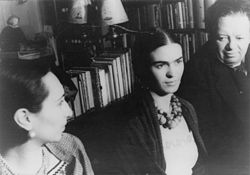 Malú Block (left), Frida Kahlo (center), and Diego Rivera were photographed in Manhattan by Carl Van Vechten in 1932 while he was working on a commissioned mural in Rockefeller Center
Malú Block (left), Frida Kahlo (center), and Diego Rivera were photographed in Manhattan by Carl Van Vechten in 1932 while he was working on a commissioned mural in Rockefeller Center
As a young artist, Kahlo communicated with the Mexican painter, Diego Rivera, whose work she admired, asking him for advice about pursuing art as a career. He recognized her talent.[20] He encouraged her artistic development and also began an intimate relationship with Frida. They were married in 1929, despite the disapproval of Frida's mother.
Their marriage was often troubled. Kahlo and Rivera both had irritable temperaments and numerous extramarital affairs. The bisexual Kahlo had affairs with both men and women, including Isamu Noguchi and Josephine Baker;[3] Rivera knew of and tolerated her relationships with women, but her relationships with men made him jealous. For her part, Kahlo was furious when she learned that Rivera had an affair with her younger sister, Cristina. The couple divorced in November 1939, but remarried in December 1940. Their second marriage was as troubled as the first. Their living quarters were often separate, although sometimes adjacent.[21]
Later years and death
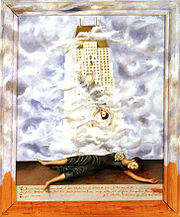 Frida Kahlo, The Suicide of Dorothy Hale, 1939, Oil on masonite, 60.4 × 48.6 cm. - The Phoenix Art Museum, Phoenix, Arizona, USA
Frida Kahlo, The Suicide of Dorothy Hale, 1939, Oil on masonite, 60.4 × 48.6 cm. - The Phoenix Art Museum, Phoenix, Arizona, USA
the legend translated:
In the city of New York on the twenty-first day of the month of October, 1938, at six o'clock in the morning, Mrs. Dorothy Hale committed suicide by throwing herself out of a very high window of the Hampshire House building. In her memory [Mrs. Clare Booth Luce commissioned][22] this retablo, executed by Frida Kahlo."[23]
Active communists, Kahlo and Rivera befriended Leon Trotsky after he gained political asylum in Mexico from Joseph Stalin's regime in the Soviet Union during the late 1930s. During 1937, Trotsky lived initially with Rivera and then at Kahlo's home (where he had an affair with Kahlo).[3] Trotsky and his wife then relocated to another house in Coyoacán where, in 1940, he was assassinated.
Frida Kahlo died on July 13, 1954, soon after turning 47. A few days before her death she wrote in her diary: "I hope the exit is joyful — and I hope never to return — Frida".[3] The official cause of death was given as a pulmonary embolism, although some suspected that she died from an overdose that may or may not have been accidental.[3] An autopsy was never performed. She had been very ill throughout the previous year and her right leg had been amputated at the knee, owing to gangrene. She had a bout of bronchopneumonia about that time, which had left her quite frail.[3]
In his autobiography, Diego Rivera would write that the day Kahlo died was the most tragic day of his life, adding that, too late, he had realized that the most wonderful part of his life had been his love for her.[3]
A pre-Columbian urn holding her ashes is on display in her former home, La Casa Azul (The Blue House), in Coyoacán, which since 1958 has been maintained as a museum housing a number of her works of art and numerous mementos and artifacts from her personal life.[3]
Posthumous recognition
 La Casa Azul in Coyoacán (photograph taken in 2005)
La Casa Azul in Coyoacán (photograph taken in 2005)
Aside from the 1939 acquisition by the Louvre, Kahlo's work was not widely acclaimed until decades after her death. Often she was remembered only as Diego Rivera's wife. It was not until the early 1980s, when the artistic style in Mexico known as Neomexicanismo began, that she became well-known to the public.[24] It was during this time that artists such as Kahlo, Abraham Ángel, Ángel Zárraga, and others gained recognition and Jesus Helguera's classical calendar paintings became famous.[24]
During the same decade of the 1980s other factors helped to make her better known. The first retrospective of Frida Kahlo’s work outside Mexico (exhibited alongside the photographs of Tina Modotti) opened at the Whitechapel Gallery in London in May 1982, organized and co-curated by Peter Wollen and Laura Mulvey. The exhibition also was shown in Sweden, Germany, Manhattan, and Mexico City. The movie Frida, naturaleza viva (1983), directed by Paul Leduc with Ofelia Medina as Frida and painter Juan José Gurrola as Diego, was a great success. For the rest of her life, Medina has remained in a quasi-perpetual Frida role.[25] Also during the same time, Hayden Herrera published an influential biography, Frida: The Biography of Frida Kahlo, which became a worldwide bestseller. Raquel Tibol, a Mexican artist and personal friend of Frida, wrote Frida Kahlo: una vida abierta.[26] Other works about her include a biography by Mexican art critic and psychoanalyst Teresa del Conde and texts by other Mexican critics and theorists, such as Jorge Alberto Manrique.[24]
From 1990–91, Kahlo's "Diego on my Mind" (1943), oil on masonite, 76 by 61 centimeters piece was used as the representative piece on the post for the Metropolitan Museum of Art's Mexico: Splendors of Thirty Centuries art exhibit. In 1991, the opera Frida by Robert Xavier Rodriguez, which had been commissioned by the American Music Theater Festival, premiered in Philadelphia.
In 1994, American jazz flautist and composer James Newton released an album inspired by Kahlo titled Suite for Frida Kahlo on AudioQuest Music (now known as Sledgehammer Blues).[27]
On June 21, 2001, she became the first Hispanic woman to be honored with a U.S. postage stamp.[28]
In 2002, the American biographical movie Frida, directed by Julie Taymor, in which Salma Hayek portrayed the artist, was released.[29] The film was based on Herrera's book. It grossed US$ 58 million worldwide.[29]
In 2005 an international exhibition of Kahlo's work was presented in London. It brought together eighty-seven of her works for the display.
In 2006, Kahlo's 1943 painting Roots set a US$ 5.6 million auction record for a Latin American work.[30]
The 2009 novel The Lacuna by Barbara Kingsolver features Kahlo, her life with Rivera, and her affair with Trotsky.
On July 6, 2010, to commemorate the anniversary of her birthday, Google altered its standard logo to include a portrait of Frida, depicted in her style of art.[31]
On August 30, 2010, the Bank of Mexico issued a new MXN$ 500-peso note, featuring Frida and her 1949 painting entitled Love's Embrace of the Universe, Earth, (Mexico), I, Diego, and Mr. Xólotl on the back of the note while her husband Diego was on the front of the note.[32]
A play based on Frida Kahlo's life was premiered at the Edinburgh Festival Fringe in 2008. 'Frida Kahlo: Viva la vida!", written by Mexican Humberto Robles and performed by Gael Le Cornec, received an Artistic Excellence Award and a best female performer nomination at the Brighton Festival Fringe in 2009.
An exhibition of works by Frida Kahlo (1907 – 1954) and Diego Rivera (1886 – 1957, 'Frida Kahlo and Diego Rivera: Masterpieces from the Gelman Collection', will be shown at Pallant House Gallery, Chichester, West Sussex from 9 July to 2 October 2011. This major touring exhibition, which comes to Chichester for its only UK showing, brings together the iconic paintings of the two central figures of Mexican Modernism, for the first time in this country.
Centennial celebration
The one hundredth anniversary of the birth of Frida Kahlo was commemorated with the largest exhibit ever held of her paintings at the Palacio de Bellas Artes, Kahlo's first comprehensive exhibit in Mexico.[33] Works were on loan from Detroit, Minneapolis, Miami, Los Angeles, San Francisco, and Nagoya, Japan. The exhibit included one-third of her artistic production, as well as manuscripts and letters that had not been displayed previously.[33] The exhibit was open June 13 through August 12, 2007 and surpassed all previous attendance records at the museum.[34] Some of her work was exhibited in Monterrey, Nuevo León, and moved during September 2007 to museums in the United States.
In 2008, a Frida Kahlo exhibition in the United States with more than forty of her self-portraits, still lifes, and portraits was shown at the Walker Art Center in Minneapolis, the Philadelphia Museum of Art, the San Francisco Museum of Modern Art and other venues.
A "Frida Kahlo Retrospective" exhibit at the Walter-Gropius-Bau, Berlin from April 30 to August 9, 2010, has brought together more than 120 drawings and paintings, including several drawings never before displayed publicly. Regarding Kahlo's "preferred" birth year (she claimed to be born in 1910 during the Mexican Revolution), the Berlin show is also being touted as a "centennial" exhibition.
La Casa Azul
Casa Azul ("Blue House") in Coyoacán, Mexico City is the family home where Frida Kahlo grew up and to which she returned in her final years. Frida's father, Guillermo Kahlo, built the house in 1907 as the Kahlo family home. Leon Trotsky stayed at this house when he first arrived in Mexico in 1937.
The home was donated by Diego Rivera upon his death in 1957, which occurred three years after the death of Frida, and the house is now a museum housing artifacts of her life. Her former home is a popular destination for tourists.
See also
- History of painting
- Self portrait
- Western painting
References
- ^ Image—full description and credit: Frida Kahlo, Self-Portrait with Thorn Necklace and Hummingbird, 1940, oil on canvas on Masonite, 24½ × 19 inches, Nikolas Muray Collection, Harry Ransom Center, The University of Texas at Austin, ©2007 Banco de México Diego Rivera & Frida Kahlo Museums Trust, Av. Cinco de Mayo No. 2, Col. Centro, Del. Cuauhtémoc 06059, México, D.F.
- ^ a b Frieda is a German name from the word for peace (Friede/Frieden); Kahlo began omitting the "e" in her name about 1935 [1]
- ^ a b c d e f g h Herrera, Hayden (1983). A Biography of Frida Kahlo. New York: HarperCollins. ISBN 978-0060085896.
- ^ "Frida Kahlo". Smithsonian.com. http://www.smithsonianmag.com/arts-culture/kahlo.html. Retrieved 2008-02-18.
- ^ Frida Kahlo by Adam G. Klein
- ^ Andrea, Kettenmann (1993). Frida Kahlo: Pain and Passion. Köln: Benedikt Taschen Verlag GmbH. p. 3. ISBN 3822896365.
- ^ a b Norma Broude, Mary D. Garrard. The Expanding discourse: feminism and art history. 1992, page 399
- ^ Karl, Ruhrberg; Manfred Schneckenburger; Christiane Fricke; Klaus Honnef (2000). Frida Kahlo: Art of the 20th Century: Painting, Sculpture, New Media, Photography. Köln: Benedikt Taschen Verlag GmbH. p. 745. ISBN 3822859079.
- ^ a b Andrea Kettenmann, Frida Kahlo. Frida Kahlo, 1907–1954: pain and passion page 27
- ^ Finding Frida Kahlo
- ^ Herrera, Hayden (1983). A Biography of Frida Kahlo. New York: HarperCollins. p. 5. ISBN 978-0060085896.
- ^ Ronnen, Meir (2006-04-20). "Frida Kahlo's father wasn't Jewish after all". The Jerusalem Post. http://fr.jpost.com/servlet/Satellite?cid=1143498883340&pagename=JPArticle%2FShowFull. Retrieved 2009-09-02.
- ^ "Frida Kahlo (1907–1954), Mexican Painter". Biography. http://www.fridakahlo.com/bio.shtml. Retrieved 2007-06-02.
- ^ Budrys, Valmantas (February 2006). "Neurological Deficits in the Life and Work of Frida Kahlo". European Neurology 55 (1): 4–10. doi:10.1159/000091136. ISSN (print), ISSN 1421-9913 (Online) 0014-3022 (print), ISSN 1421-9913 (Online). PMID 16432301. http://content.karger.com/produktedb/produkte.asp?typ=fulltext&file=ENE2006055001004. Retrieved 2008-01-22.
- ^ The History Show on RTE Radio 1, Sunday 17 April 2011
- ^ Cruz, Barbara (1996). Frida Kahlo: Portrait of a Mexican Painter. Berkeley Heights: Enslow. p. 9. ISBN 0-89490-765-4.
- ^ "Frida Kahlo". The Jewish Mexicana. http://www.virginiajewishlife.com/art-gallery.html. Retrieved 6 July 2010.
- ^ Kahlo's Surrealist drawing, Diego'[dead link]
- ^ Kahlo's Surrealist drawing, Frida[dead link]
- ^ "Movie Review: Frida". The Life of Frida Kahlo, Famed Mexican. http://newslions.info/5144/movie-review-frida-the-life-of-frida-kahlo-famed-mexican. Retrieved 6 July 2010.
- ^ "Mexican painter Frida Kahlo". Frida Kahlo Google Doodle. http://buzzytimes.com/frida-kahlo-mexican-painter-frida-kahlo-frida-kahlo-google-doodle/. Retrieved 6 July 2010.
- ^ These words were subsequently painted out by Kahlo on Luce's request.
- ^ Andrea Kettenmann (1999). Frida Kahlo: 1907–1954 Pain and Passion. Taschen. ISBN 3822859834.
- ^ a b c Emerich, Luis Carlos (1989). Figuraciones y desfiguros de los ochentas. Mexico City: Editorial Diana. ISBN 968-13-1908-7.
- ^ "Cada quién su Frida, stage piece". Cada quien su Frida. http://www.cadaquiensufrida.blogspot.com. Retrieved 2007-08-19.[dead link]
- ^ Tibol, Raquel (original 1983, English translation 1993 by Eleanor Randall) Frida Kahlo: an Open Life. USA: University of New Mexico Press. ISBN 082631418X
- ^ "Suite for Frida Kahlo". Valley Entertainment. http://www.valley-entertainment.com/suite-for-frida-kahlo-2.html. Retrieved 6 July 2010.
- ^ "Stamp Release No. 01-048 - Postal Service Continues Its Celebration of Fine Arts With Frida Kahlo Stamp". USPS. http://www.usps.com/news/2001/philatelic/sr01_048.htm. Retrieved 2010-10-29.
- ^ a b "Frida (2002)". Boxofficemojo.com. http://boxofficemojo.com/movies/?id=frida.htm. Retrieved 2010-10-29.
- ^ "Frida Kahlo " Roots " Sets $5.6 Million Record at Sotheby's." Art Knowledge News. 2006 (retrieved 23 August 2011)
- ^ "Frida Kahlo Google logo". Google. http://www.google.com/logos/frida10-hp.gif. Retrieved 29 October 2010.
- ^ "Presentación del nuevo billete de quinientos pesos". Bank of Mexico. http://www.banxico.org.mx/billetes-y-monedas/informacion-general/billetes-y-monedas-de-fabricacion-actual/billete-de-500-pesos/material-educativo/%7B601FEB0F-63F6-A3AF-C803-A064AC6BEE74%7D.pdf. Retrieved 11 September 2010.
- ^ a b "Largest-ever exhibit of Frida Kahlo work to open in Mexico". Agence France Presse, Yahoo News (May 29, 2007). http://news.yahoo.com/s/afp/20070529/ts_afp/lifestylemexicoart;_ylt=AqZA2wEU4xXMSdvFy41TY44DW7oF. Retrieved 2007-05-30.[dead link]
- ^ "Centenary show for Mexican painter Kahlo breaks attendance records". People's Daily Online (August 14, 2007). http://english.people.com.cn/90001/90782/6239310.html. Retrieved 2007-08-21.
Bibliography
- Pierre, Clavilier (2006). Frida Kahlo, les ailes froissées, ed Jamsin ISBN 9782912080530
- Fuentes, C. (1998). Diary of Frida Kahlo. Harry N. Abrams, Inc. (March 1, 1998). ISBN 0-8109-8195-5.
- Gonzalez, M. (2005). Kahlo – A Life. Socialist Review, June 2005.
- Arts Galleries: Frida Khalo. Exhibition at Tate Modern, June 9 – October 9, 2005. The Guardian, Wednesday May 18, 2005. Retrieved May 18, 2005.
- Nericcio, William Anthony. (2005). A Decidedly 'Mexican' and 'American' Semi[er]otic Transference: Frida Kahlo in the Eyes of Gilbert Hernandez.
- Tibol, Raquel (original 1983, English translation 1993 by Eleanor Randall) Frida Kahlo: an Open Life. USA: University of New Mexico Press. ISBN 082631418X
- Turner, C. (2005). Photographing Frida Kahlo. The Guardian, Wednesday May 18, 2005. Retrieved May 18, 2005.
- Zamora, M. (1995). The Letters of Frida Kahlo: Cartas Apasionadas. Chronicle Books (November 1, 1995). ISBN 0-8118-1124-7
- The Diary of Frida Kahlo. Introduction by Carlos Fuentes. Essay by Sarah M. Lowe. London: Bloomsburry, 1995. ISBN 0-7475-2247-2
- Griffiths J. (2011). A Love Letter from a Stray Moon, Text Publishing, Melbourne Australia (forthcoming).
- "Frida's bed" (2008) - a novel based on the life of Frida Kahlo by Croatian writer Slavenka Drakulic. Penguin (non-classics) ISBN 978-0143114154
External links
- Frida Kahlo at the Open Directory Project.
- The official Frida Kahlo Site
- The complete works of Frida Kahlo
- Frida Kahlo at the Museum of Modern Art
- "Frida Kahlo & contemporary thought" contains an extensive bibliography
- Gallery of Frida Kahlo self-portraits
- Frida nudes photos by Julien Levy, 1938
- Frida Kahlo bio site with biography, paintings, drawings, sketches, chronology, books, films, auction results and photos
- Frida Kahlo Retrospective at Bank Austria Kunstforum, 2010 Frida Kahlo Retrospective at Bank Austria Kunstforum, Vienna, Austria 2010
Categories:- 1907 births
- 1954 deaths
- Bisexual artists
- Deaths from pulmonary embolism
- Latin American artists of indigenous descent
- LGBT people from Mexico
- Mexican amputees
- Mexican painters
- Mexican Trotskyists
- Mexican communists
- Modern painters
- People from Mexico City
- People with poliomyelitis
- Surrealist artists
- Mexican people of German descent
- 20th-century Indigenous Mexican painters
- 20th-century Indigenous painters of the Americas
- People with disabilities
- Frida Kahlo
Wikimedia Foundation. 2010.

